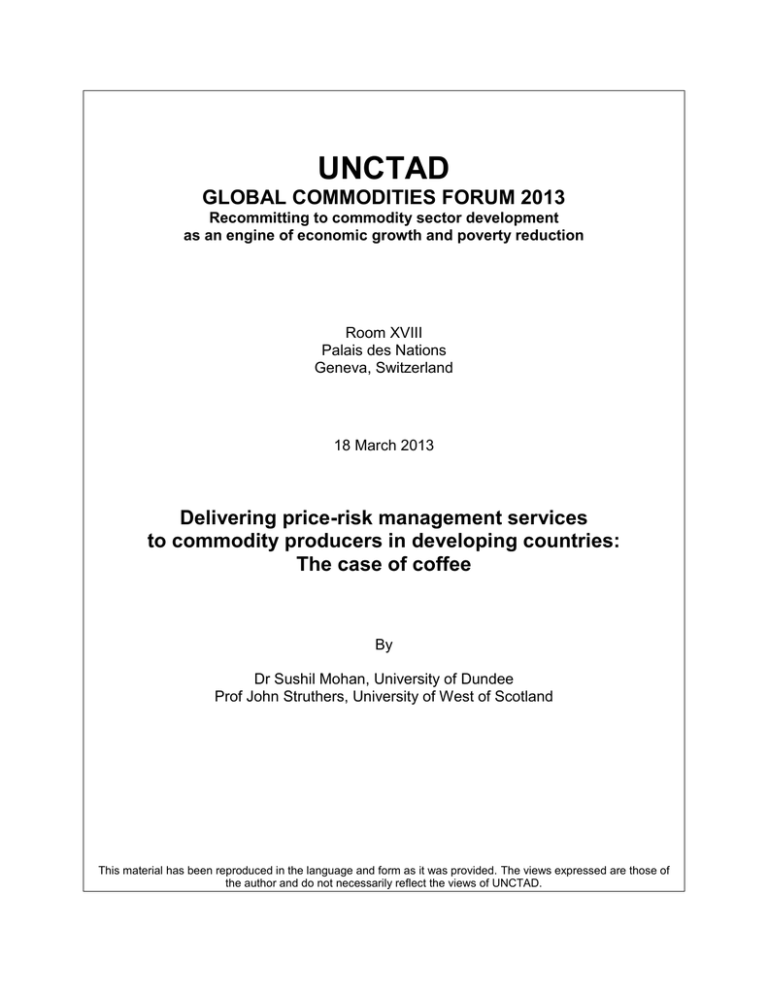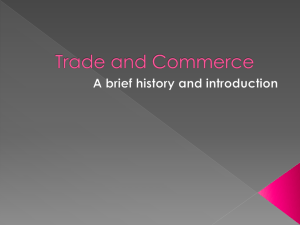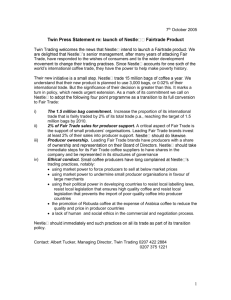UNCTAD
advertisement

UNCTAD GLOBAL COMMODITIES FORUM 2013 Recommitting to commodity sector development as an engine of economic growth and poverty reduction Room XVIII Palais des Nations Geneva, Switzerland 18 March 2013 Delivering price-risk management services to commodity producers in developing countries: The case of coffee By Dr Sushil Mohan, University of Dundee Prof John Struthers, University of West of Scotland This material has been reproduced in the language and form as it was provided. The views expressed are those of the author and do not necessarily reflect the views of UNCTAD. Delivering price‐risk management services to commodity producers in developing countries: The case of coffee Dr Sushil Mohan, University of Dundee Prof John Struthers, University of West of Scotland Introduction • Coffee is the developing world's biggest trading commodity – Grown by over 10 m small producers • Coffee is characterised by high price volatility – exposes producers to high levels of price risk • How can producers manage this risk? – Can coffee futures markets deliver price risk‐ management services to producers? 2 Why manage price‐risk? • Use of futures markets involve costs – so benefits for producers should be > costs • Theoretical/field evidence shows that benefit can potentially be quite high – Hedging lowers the variance of return for a producer with a income utility function (with risk aversion) • Allows producers to allocate resources more efficiently for production/marketing of coffee • Results in a higher expected return 3 The ITF risk‐management mechanism • Producers access coffee futures (ICE/LIFFE) instruments through local intermediaries – Instrument suggested is purchase of ‘put options’ • Strike price of put guarantees a price insurance to producers (of a minimum price floor) • How practical is this? – Local intermediaries obstruct flow of information • Charge high margins to cover their risk – Ignores needs of exporters & traders 4 Development of local exchange • Advantages – lower basis‐rate risk – price discovery information more transparent to producers and local traders – Customised contracts – Caters to needs of most market participants • Limitations – Lack of liquidity because of limited participation & low speculator activity – High costs of developing exchange 5 Branch of ICE NY or LIFFE London • Main exchanges integrate backwards to provide risk‐management instruments directly to entities in producer countries • Advantages – Most of the benefits of local exchange – Achieve economies of scale from pooling the risk – Price of contracts determined in an actuarially fair way – Main exchange can play a vital role in providing infrastructure and training 6 Limitations • Does not offer the advantage of lower basis risk as in local exchange – Part of basis risk from frictions in information flow from main exchanges to producing markets • Flow likely to improve with the activities in the branch exchange • Some basis risk will always remain • Adjusting contract sizes to the needs of producers and entities in producing countries 7 Contract size • Transaction cost of reducing exchange‐traded contract size and ensuring its availability may be prohibitive – Economies of scale may enable provision of the instrument in bulk at reduced cost – Contract size need not be very small • Main clients commercially oriented producers; may have small land plots but produce reasonable market surplus • Promoting flexible OTC products to supplement exchange‐traded product can be helpful – OTC providers more active in branch exchange as easier for them to offset their risk 8 Viability • Branch Exchange success depends on volume of business – Benefit from reputation of main exchange • Attract financial institutions, brokers, traders & speculators who will provide it with liquidity & critical mass required for a vibrant exchange – Greater degree of vertical integration in commodity markets • Importers/ traders keen to locate in producing countries – Branch Exchange offers opportunities to offset their risks – Branch could deal in diversified hedging activities 9 The way ahead • Setting local exchanges may be premature • Branch exchanges provide the same service as ITF mechanism, with a wider scope & most benefits of local exchange • Focus on coffee, but can be extended to other commodities traded in commodity exchanges • Future work should study feasibility of setting branch exchanges 10 Selected References • Banerjee, A; Mohan, S and Russell, B (2013), “Coffee Market Liberalisation and the Implications for Producers in Brazil, Guatemala and India ”, World Bank Economic Review, 26(3): 514‐ 538 • Gemech, F, Mohan, S, Reeves, A and Struthers, J, (2011), “Market‐ based Price‐Risk Management: Welfare Gains for Coffee Producers from Efficient Allocation of Resources”, Oxford Development Studies, 39 (1), pp 49‐58 • Mohan, S, (2007), “Market‐based Price‐Risk Management for Coffee Producers”, Development Policy Review. 25 (3) pp 333‐354. • Gemech, F and Struthers, J (2007), “Coffee Price Volatility in Ethiopia: effects of Market Reform Programmes”, Journal of International Development, 19 (8), pp 1131‐1142 • Mohan, S and Love,J. “Coffee futures: Role in reducing coffee producers’ price risk” (2004), Journal of International Development, 16(7), 983‐1002 11






